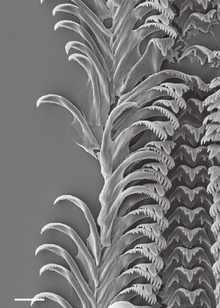Radula
In most of the more ancient lineages of gastropods, the radula is used to graze, by scraping diatoms and other microscopic algae off rock surfaces and other substrates.
Predatory marine snails such as the Naticidae use the radula plus an acidic secretion to bore through the shell of other mollusks.
[3] A typical radula comprises a number of bilaterally-symmetrical self-similar rows of teeth rooted in a radular membrane in the floor of their mouth cavity.
[7] The teeth often tesselate with their neighbours, and this interlocking serves to make it more difficult to remove them from the radular ribbon.
[7] The number, shape, and specialized arrangement of molluskan teeth in each transverse row is consistent on a radula, and the different patterns can be used as a diagnostic characteristic to identify the species in many cases.
However, it is not fixed per species; some mollusks can adapt the form of their radular teeth according to which food sources are abundant.
[9] The radula is used in two main ways: either as a rake, generally to comb up microscopic, filamentous algae from a surface; or as a rasp, to feed directly on a plant.
On the other hand, the docoglossan gastropod radula allows a very similar diet to the polyplacophora, feeding primarily on these resistant algae, although microalgae are also consumed by species with these radular types.
[10] The sacoglossans (sea slugs) form an interesting anomaly in that their radula comprises a single row; they feed by sucking on cell contents, rather than rasping at tissue, and most species feed on a single genus or species of alga.
Triangular teeth are suited to diets of calcified algae, and are also present in radulae used to graze on Caulerpa; in both these cases the cell walls are predominantly composed of xylan.
The tip of the odontophore then scrapes the surface, while the teeth cut and scoop up the food and convey the particles through the esophagus to the digestive tract.
Large numbers of teeth in a row (actually v-shaped on the ribbon in many species) is presumed to be a more primitive condition, but this may not always be true.
Cone shells have a single radular tooth, that can be thrust like a harpoon into its prey, releasing a neurotoxin.
The ptenoglossan radula is situated between the two extremes and is typical for those gastropods which are adapted to a life as parasites on polyps.
[22]: 110 The cephalopod radula rarely fossilizes: it has been found in around one in five ammonite genera, and is rarer still in non-ammonoid forms.
Indeed, it is known from only three non-ammonoid taxa in the Palaeozoic era: Michelinoceras, Paleocadmus, and an unnamed species from the Soom Shale.
[23] The solenogaster radula is akin to that of other mollusks, with regularly spaced rows of teeth produced at one end and shed at the other.




The rest of the body of the snail is shown in green. The food is shown in blue. Muscles that control the radula are shown in brown. The surface of the radular ribbon, with numerous teeth, is shown as a zig-zag line






